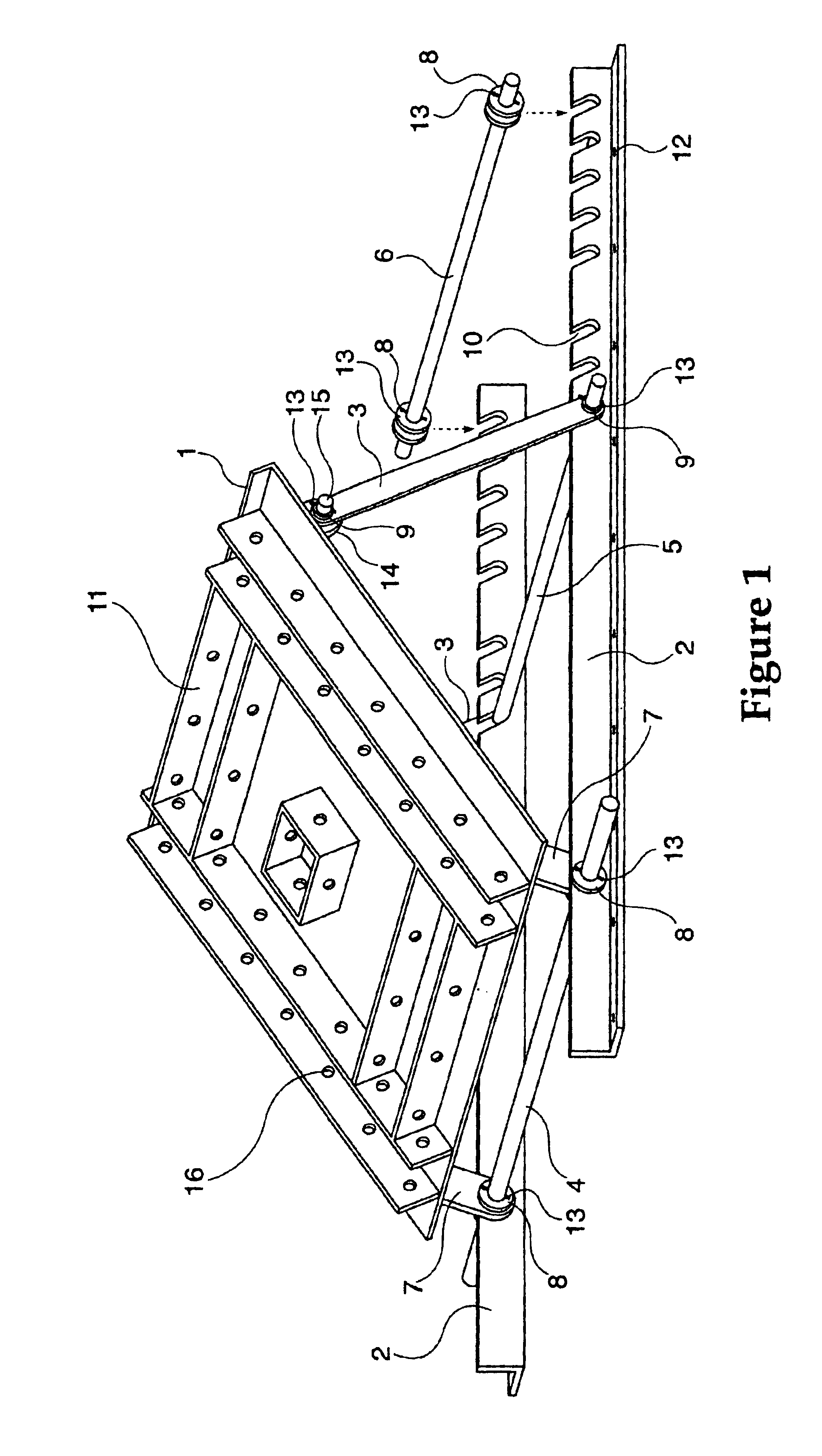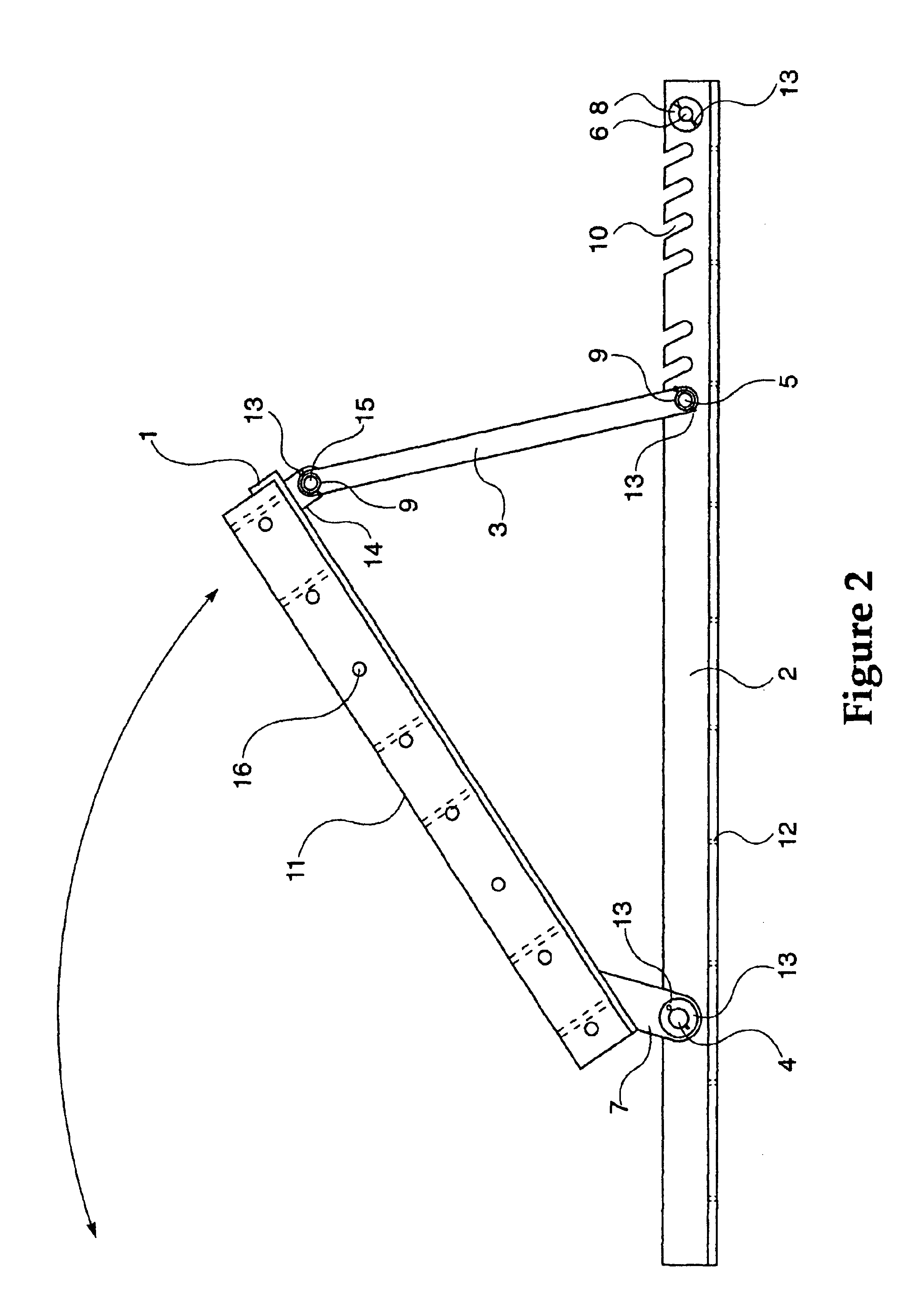An alarming number of construction site accidents are due to falls from pitched roofs by workmen, or injuries sustained by workmen when roofing materials (
shingles, felt, nails, flashing, compounds, sealants, and the like) or tools (hammer, nail guns, water jugs, and the like) fall from a roof onto workers or passersby below.
One of the basic difficulties in roof work is transporting the materials up to the roof and storing them there until needed.
Thus, large quantities of
shingles, tiles,
slates, or the like, may need to be stored on the roof prior to installation.
If a fellow workman or passerby is below when such a large amount of material falls, serious injury or even death can occur.
In addition, although probably less hazardous, workers and passersby below are also in danger of serious injury from falling tools, hammers, and smaller amounts of roofing materials and the like.
In addition to causing stress on the body, such a work environment is inefficient, as such long reaches increase the time needed to install
shingles and more readily fatigue the roofer.
Moreover, extended reaches may put the roofer at increase risk of falling due to loss of balance and the like.
Roofing materials and tools may be more likely to fall off a roof if a roofer has to stretch to reach them.
Such a primitive technique, commonly used, provides very little purchase for the roofer or materials to rest upon.
In addition, it may take time at the jobsite for the roofer to secure such
scrap lumber,
cut it to size, measure for nail spacing, and install.
However, most, if not all, of these attempts have failed in one or more ways, and none of these patented invention appear to have been commercially successful or readily available in the marketplace.
Most of these schemes utilize unnecessarily complicated apparatus, which is too costly for the average roofer to afford, to heavy to lift to the jobsite, and to cumbersome to work with.
The problem with the Eisenmenger
system is that it requires that a ladder with specialized fittings first be hauled up to the roof and secured before the platform can be installed.
However, it appears that Bitner is limited to a device for supporting a walk-board or
plank, and does not explicitly provide support for ladders, tools, supplies, or roofing materials.
In addition, the Bitner device utilizes a fairly complex and expensive screw-jack leveling
system to provide infinite adjustment of angle.
While the screw-jack system may provide more levels of adjustment, it does so at the expense of added cost and complexity.
Moreover, the screw-jack of Bitner does not appear to be sufficient to support large loads (e.g., square of shingles).
As the pad is made entirely of
foam rubber, it may be difficult to grip (no handles).
Moreover, the foam pad does not provide storage for small items such as nails or tools.
In addition to the above problems in the Prior Art, injuries have occurred when ladders and scaffolding set up for roof and other work are not properly secured and as a result, fall down.
However, oftentimes a convenient and easy way to tie off a ladder (e.g., to a gutter) is not present, particularly with regard to roofing work.
An aluminum ladder flying off a construction
truck can cause great bodily injury or even death on a crowded superhighway.
Such dangers
pose huge liabilities for construction companies which may be ultimately responsible for the actions of their employees.
Moreover, securing any load to a vehicle present safety problems.
However contractors and homeowners have relied upon straps, ropes and even strings, to secure loads to their vehicles, with limited success and sometimes disastrous results.
Many contractors will leave ladders entirely unsecured on ladder racks, or use only a token string or
rope to secure them.
In addition to being unsafe, ropes and strings are difficult to tie and untie.
Straps (since or
ratchet) are one solution, however, they are generally provided with large rubber hooks which may slip on a ladder or luggage rack or may be difficult to secure.
However, the YAKIMA® and THULE® racks may be highly specialized in their purposes and thus require an enormous amount of accessories in order to secure various items.
Moreover, accessories for one rack (e.g., YAKIMA®, which uses round tubing) may not fit another rack (e.g., THULE®, which uses square tubing).
Luggage racks supplied with cars generally are of little use and provide few or no places for tie-downs or the like.
However, there is little precision in
depth of cut with a knife, and in addition, such a
cut can be laborious and difficult.
Too deep a
cut may create roof leaks.
Power tools are generally not well suited to
cutting shingles.
Most are heavy and require electrical power.
In addition, large power tools present a
hazard to workers below if they fall off the roof.
While the Stein hat may provide some cooling, particularly in dry climates, in many more humid climates, it may provide little more than a wet hat.
However, the McPherson design still passes water through the hat, which may result it little more than a wet hat, and little cooling.
Thus, even if these devices provide any substantial cooling to the wearer, they need to be replenished on a regular basis.
However, there are safety concerns with such systems.
In particular, if the pump jack poles are not securely fastened to the ground or building, the entire
assembly can tip over, causing injury or death to workers on the scaffold board or working below.
Uneven or sloped
terrain may cause the pump jack poles to move laterally.
Roofing tools are always at a risk of falling off a roof, especially an inclined roof.
In addition to the inconvenience of having to retrieve such tools and possible damage to a tool from such a fall, there is the
hazard that such tools present to workers below.
Nailguns and the like present an additional
hazard in that they may go off when they hit the ground and further injure other workers or passersby.
Mounting a ladder to an inclined roofing surface can be dangerous.
If the ladder is not securely fastened to the roof, it may slide off, taking the user with it.
However, such a technique requires that the ladder be put onto the roof surface first, and slid all the way to the top.
For large roofs, or roofs with compound or unusual peak configurations, the J-hook may not be suitable for use.
However, there is little precision in
depth of cut with a knife, and in addition, such a cut can be laborious and difficult.
Too deep a cut may create roof leaks.
Power saws and the like are difficult to use as the saw may require an extension cord on the roof and also the blade may not be well suited for
cutting shingles (i.e., it will “load up” with
tar and other materials and cease to cut well).
In addition, large power tools present a hazard to workers below if they fall off the roof.
Roofing tools are always at a risk of falling off a roof, especially an inclined roof.
In addition to the inconvenience of having to retrieve such tools and possible damage to a tool from such a fall, there is the hazard that such tools present to workers below.
Nailguns and the like present an additional hazard in that they may go off when they hit the ground and further injure other workers or passersby.
Mounting a ladder to an inclined roofing surface can be dangerous.
If the ladder is not securely fastened to the roof, it may slide off, taking the user with it.
However, such a technique requires that the ladder be put onto the roof surface first, and slid all the way to the top.
For large roofs, or roofs with compound or unusual peak configurations, the J-hook may not be suitable for use.
Flashing that is poorly installed, bent, wrinkled, or the like, can cause leaks and detract from the appearance of a finished roof.
Unfortunately, the material may roll around in the
truck, and moreover, workers may drop tools on it and the like.
As a result, a roofer may be forced to throw away many half-used rolls of flashing material, as the material may be damaged by such rough handling.
In addition, measuring and
cutting such material may be awkward and difficult when handling an open roll of flashing or the like.
Laying a ladder on a roof can be problematic as well.
One problem with roofing jobs in general is that when roofers step on a completed roof surface, lay tools upon it, or drag materials, ladders, scaffolding, or the like, the roof surface may be marred, particularly in warm weather when the
asphalt in the
asphalt shingles may be soft.
In any event, it presents a problem in that homeowners may perceive such marring as roofing damage and complain to the roofer, causing
much difficulty, as such marring may be impossible to repair other than to re-roof the entire house.
Ladders laid against surfaces can slide and fall, causing injury.
A ladder laid against a narrow object such as a pump jack pole may tend to wobble and tip, which can cause the ladder (and worker) to fall.
Moving materials up and down a roof surface is difficult, particularly with heavy materials such as roofing tile.
Laddervaters are known to get materials up to a roof surface, but laddervaters cannot be used to move materials around the roof surface itself.
When removing tiles from a roof, for example, it can be cumbersome and dangerous to walk across the roof surface carrying such tiles.
Placing a ladder on uneven ground will inevitably result in the ladder being unstable or tipping over.
Using blocks of wood or the like to level a ladder is dangerous, awkward, and cumbersome.
 Login to View More
Login to View More 


